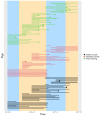Evaluating the Role of Corrals and Insects in the Transmission of Porcine Cysticercosis: A Cohort Study
- PMID: 37111483
- PMCID: PMC10143142
- DOI: 10.3390/pathogens12040597
Evaluating the Role of Corrals and Insects in the Transmission of Porcine Cysticercosis: A Cohort Study
Abstract
The widespread dispersion of pigs infected with cysticercosis across endemic villages, low cyst burden among infected pigs, and low prevalence of taeniasis all suggest that pig ingestion of human feces is not the only mode of transmission for Taenia solium. Our objective was to evaluate the risk of porcine cysticercosis associated with exposure to human feces, dung beetles, and flies in an endemic community setting. We used a cluster-randomized cohort design to compare the risk of developing antibodies and infection among 120 piglets raised in either free-roaming (FR), standard corral (SC), or netted corral environments (NC). We collected monthly blood samples to detect serum antibodies and necropsied all pigs after 10 months to identify cysts. A total of 66 piglets developed antibodies with the relative risk of seropositivity in FR vs. all corralled pigs increasing significantly after 18 weeks. Of 108 necropsied pigs, 15 had T. solium cysts, all belonging to the FR group. Corrals were protective against infection but less so against seropositivity. NC, which did not completely exclude insects, did not provide added protection against seropositivity as compared to SC. The results of this study suggest that dung beetles and flies do not play an important role in infection.
Keywords: cohort; corrals; free roaming; insects; porcine cysticercosis; seroincidence.
Conflict of interest statement
The authors declare no conflict of interest. The funders had no role in the design of the study; in the collection, analyses, or interpretation of data; in the writing of the manuscript; or in the decision to publish the results.
Figures



References
-
- World Health Organization . Working to Overcome the Global Impact of Neglected Tropical Diseases—First WHO Report on Neglected Tropical Diseases. 1st ed. World Health Organization; Paris, France: 2010. p. 132.
-
- Lawson J.R., Gemmell M.A. Advances in Parasitology. Volume 22. Elsevier; Amsterdam, The Netherlands: 1983. Hydatidosis and Cysticercosis: The Dynamics of Transmission; pp. 261–308. - PubMed
Grants and funding
LinkOut - more resources
Full Text Sources

